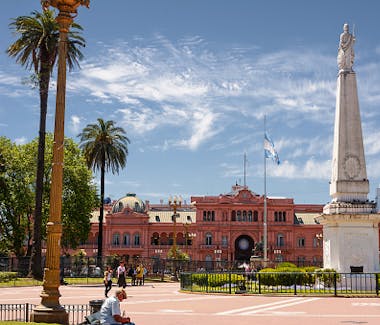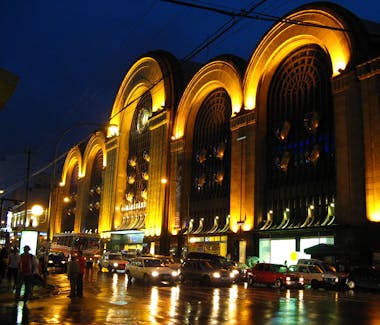Attractions

Puerto Madero, Buenos Aires, Argentina
Puerto Madero
Puerto Madero, also known within the urban planning community as the Puerto Madero Waterfront, is a Buenos Aires neighborhood in Argentina in the central business district, occupying a significant portion of the Rio de la Plata riverbank and representing the latest architectural trends.

Calle Florida, Florida, Buenos Aires, Argentina
Florida Street
Florida is a popular shopping street in Downtown Buenos Aires, Argentina. A pedestrian street since 1971, some stretches have been pedestrianized since 1913.
Florida is one of the city's leading tourist attractions. Florida Street bustles with shoppers, vendors, and office workers alike because of its proximity to the financial district. By evening, the pace relaxes as street performers flock to the area, including tango singers and dancers, living statues, and comedy acts. Its variety of retail stores, shopping arcades, and restaurants is of great interest to foreign tourists and business travelers.

Galerías Pacífico, Avenida Córdoba, Buenos Aires, Argentina
Galerías Pacífico
Galerías Pacífico is a shopping centre in Buenos Aires, Argentina, located at the intersection of Florida Street and Córdoba Avenue.
Like the Bon Marché in Paris, at the end of the 19th century, Francisco Seeber and Emilio Bunge created the Bon Marché Argentino. A place that would offer the latest expressions of world fashion. Thus was born an imposing architectural work, with intersecting streets, glass vaults and a spacious and elegant central dome.
In 1908, a construction sector was sold to the Buenos Aires al Pacífico railway. In 1945 the architects Jorge Aslan and Héctor Ezcurra planned the remodeling of the building, separating the shopping gallery from the railway offices and including the murals in the central dome.
In 1989, the building was declared a National Historic Monument and later, it was handed over to Galerías Pacífico S.A. and on May 18, 1992, the magnificent Commercial and Cultural Center was inaugurated.

Plaza de Mayo, Avenida Hipólito Yrigoyen, Buenos Aires, Argentina
Plaza de Mayo
Just 10 minutes from the hotel, we will find the epicenter of the most important political events in Argentine history. Bordering the Plaza de Mayo there are several historic and governmental buildings: the Cabildo, the Metropolitan Cathedral, the Government House (also known as Casa Rosada, seat of the National Government), the Government Palace of the City, banks and ministries.
It is advisable to walk along one of the oldest and most important avenues in the city, Avenida de Mayo, which connects the Casa Rosada with the National Congress and houses the historic Plaza de Mayo. There we can find the House of Culture of the city, the National Academy of Tango and other points of interest such as the legendary Café Tortoni.


Av. Corrientes, Buenos Aires, Argentina
Corrientes Avenue
During the day and night, it is recommended to take a walk along the emblematic avenue that offers artistic and cultural alternatives at all times.
Because of its nightlife it is known as "the street that never sleeps" and this is mainly because this avenue also offers the largest concentration of bookshops, theaters, pizzerias and bars in Buenos Aires, its movement does not rest until the last theater performance ends


La Boca, Buenos Aires, Argentina
La Boca, Caminito
With its typical tenements (conventillos) of different colors, it is also an open-air museum of almost 150 meters in length. It was thanks to the initiative of several neighbors, among whom was the painter Benito Quinquela Martín (one of the main benefactors of the neighborhood and whose work is commemorated through the colorful houses of La Boca), that in the 1950s the land was recovered to turn it into a pedestrian promenade and a museum street, in which works by different artists were gradually added.
Inside La Boca we can also visit the stadium "La Bombonera", the famous football team Boca Juniors, the cultural center and the show room "The Art Plant" and enjoy art in the private center of The Proa Foundation and the renowned Benito Quinquela Martin Museum


Teatro Colón, Cerrito, Buenos Aires, Argentina
Teatro Colón
With more than a century of existence, it is one of the must-sees in the world of lyric, at the height of La Scala in Milan, the Opéra Garnier in Paris and the Royal Opera House in London.
The construction of the new building took about 20 years, being inaugurated on May 25th, 1908 with a function of Aida.
As of 2010, the Teatro Colón exhibits a building restored in all its original splendor, giving a framework of distinguished hierarchy to its presentations.

Obelisco, 9 de Julio Avenue, Buenos Aires, Argentina
Obelisco
The Obelisk is the largest emblem of the city and its inhabitants.
Inaugurated in 1936 to commemorate the fourth centenary of the first foundation of Buenos Aires, it is the work of the architect Alberto Prebisch, one of the main exponents of Argentine modernism and author also of the neighboring Teatro Gran Rex. It is located in the place where the national flag was first hoisted in the city, strategically at the intersection of two of the most important avenues: the 9 de Julio, among the widest in the world, and the "street" Corrientes, one of the main cultural poles of the city.



Recoleta, Buenos Aires, Argentina
Recoleta
The neighborhood stands out for its historical monuments and large cultural spaces, among which are the National Museum of Fine Arts, the Recoleta Cultural Center and the National Library.
Among the most interesting points of Recoleta is the Recoleta Cemetery, which is a National Historic Monument and the most visited in the city, for its numerous and imposing mausoleums and vaults, belonging to many of the main protagonists of Argentine history, such as Eva Perón (Evita).

